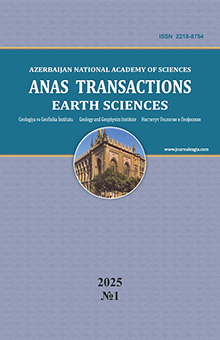№ 2,
2021
Download the article
A study of the stress state of rocks in the near-wellbore zone of the Middle Eocene sediments in the Tarsdallar deposit
Azerbaijan State Oil and Industry University 34, Azadlig ave., Baku, Azerbaijan, AZ1010: namat.pashayev@mail.ru
Summary
A-
A+
The goal of geophysical well logging (GWL) is to assess the physical properties of rocks composing the studied section.
The solution of this problem is complicated by the fact that the properties of rocks in the well-bore zone differ from the unaltered part of the rock mass as a result of mechanical collapse of rock integrity during the drilling, redistribution of tension in the wellbore zone, and the formation of a permeable zone as a result of absorption of drilling mud into the reservoir. The research depth of most GWL methods does not extend beyond the limits of the permeability zone. The permeability zone differs from the unaltered part of the formation (beyond the wellbore wall) due to its physical properties. They affect the readings of GWL methods, distorting them in comparison with the results of measurements on models of homogeneous media. In this sense, it is of considerable interest to assess the stress state of rocks near the wellbore and the impact of this state on the physical characteristics of the rocks.
The paper provides recommendations on the necessity of stress state accounting of the near-wellbore zone to reduce errors in the quantitative interpretation of GWL data and to obtain reliable results. The analytical calculations of stresses are carried out to assess changes in the stress state of rocks in the near-wellbore zone over time. A numerical implementation of the approach and examples comparing the proposed approach with practical examples are given.
The solution of this problem is complicated by the fact that the properties of rocks in the well-bore zone differ from the unaltered part of the rock mass as a result of mechanical collapse of rock integrity during the drilling, redistribution of tension in the wellbore zone, and the formation of a permeable zone as a result of absorption of drilling mud into the reservoir. The research depth of most GWL methods does not extend beyond the limits of the permeability zone. The permeability zone differs from the unaltered part of the formation (beyond the wellbore wall) due to its physical properties. They affect the readings of GWL methods, distorting them in comparison with the results of measurements on models of homogeneous media. In this sense, it is of considerable interest to assess the stress state of rocks near the wellbore and the impact of this state on the physical characteristics of the rocks.
The paper provides recommendations on the necessity of stress state accounting of the near-wellbore zone to reduce errors in the quantitative interpretation of GWL data and to obtain reliable results. The analytical calculations of stresses are carried out to assess changes in the stress state of rocks in the near-wellbore zone over time. A numerical implementation of the approach and examples comparing the proposed approach with practical examples are given.
Keywords: lateral pressure, radial and azimuthal stress, wellbore zone, drilling mud, temperature stress
REFERENCES
Akselrod S.M., Pashaev N.V. Correction the P-wave velocity measured in acoustic logging to undisturbed bedrock condi-tions. In: Thematic collection of scientific papers, Baku, 1991, pp. 19-24 (in Russian).
Gusein-zade O.D, Shilov G.Ya., Gusein-zadeh N.O., Esipov Yu.M., Khalikov Ch.I. Geostatic pressure and rock stress-strain issues in the context of contemporary crustal movements in oil and gas fields. Oil and Gas, Baku, No. 5-6, 1992, pp. 8-13 (in Russian).
Knez D. Stress state analysis in aspect of wellbore drilling direction. Arch. Min. Sci., Vol. 59, No. 1, 2014, pp. 71-76.
Kovalev A.L. Filtration and strength calculation of the vicinity of a vertical wellbore using the Drucker-Prager plasticity criterion. In scientific and technical collection: Vesti Gazovoy Nauki, No. 2 (18), 2014, pp. 36-43 (in Russian).
Koptev V.I. Velocity distribution in the vicinity of cylindrical workings in relation to their stress state. Proceedings of Hydroproject, Collection 21, Engineering Geophysics, 1971, pp. 41-60 (in Russian).
Manakov A.V. Joint modeling of geomechanical and filtration processes in the near-wellbore zone. PhD thesis. Novosi-birsk, 2014, 146 p. (in Russian).
Savich A.I., Koptev V.I., Nikitin V.N., Yashchenko Z.G. Seismoacoustic methods for studying rock massifs. Nedra. Moscow, 1969, 239 p. (in Russian).
Seitmuratov A.Zh., Umbetov U., Makhambaeva I.U. Methodology for calculating the stress-strain state of the rock mass around open and underground workings. Sci. and world, No. 3(7), Vol. 1, 2014, pp. 200-207 (in Russian).
Shiming He, Jun Zhou, Ming Tang. Research on wellbore stress in underbalanced drilling horizontal wells considering anisotropic seepage and thermal effects. Journal of Natural Gas Science and Engineering, Vol. 45, 2017, pp. 338-367.
DOI:
10.33677/ggianas20210200062
